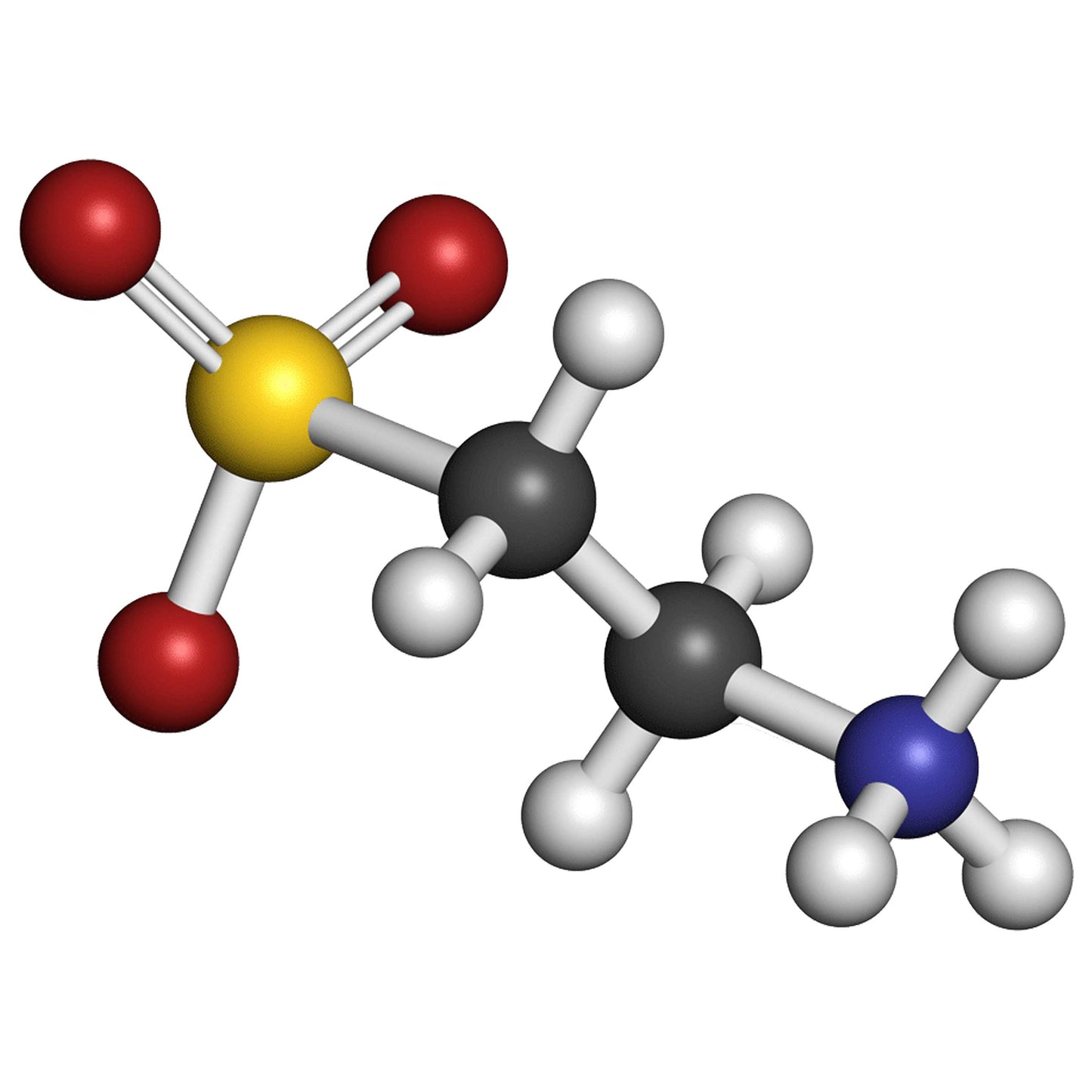
Overview
Taurine’s primary effect in Maximum Mind formulation is to increase the penetration rate of other compounds, thus enabling Marco’s Grounds to use lesser, safer doses and yet still produce the desired effect.
There are a host of other taurine benefits, many of which stem from its antioxidant properties. For mood, taurine can be a powerful drug as well. Studies suggest taurine activates GABA and glycine receptors, which provide an anxiolytic (anti-anxiety) effect. Taurine also plays a role in memory formation and learning ability as well. Several studies have found that taurine increased long-term potentiation, synaptic activity, and memory formation. Other studies showed that taurine could increase BDNF (brain-derived neurotrophic factor), which acts as fertilizer for the brain and new memories.

Other Common Names
L-Taurine
Top Benefits
Supports brain function
Supports cognitive function
Supports mood
Supports antioxidant defenses
Supports cardiovascular function
Functions as permeation enhancer
What Is Taurine?
Taurine is an organic amino sulfonic acid naturally produced in our body in small quantities. It has nootropic and neuroprotective actions and can improve memory and has anxiolytic effects. Taurine energizes and enhances mental performance without the crash or addictive potential of stimulants. Maximum Mind taurine is working as a permeation enhancer – a molecule that facilitates other molecules in the formula penetration into cells. In our formula, taurine facilitates the entry of cognition-enhancing molecules into the brain through the blood-brain barrier [23, 24]. This enables Marco’s Grounds to use lighter doses for consistently high results (see Marco’s Grounds Dosing Philosophy)
Taurine Key Mechanisms
Brain Function
Supports synaptic long-term potentiation [1]
Modulates GABAergic neurotransmission [2–5]
Modulates glycinergic neurotransmission [6]
Upregulates BDNF production [5]
Cognitive Function
Supports short-term memory [5]
Mood
Supports mood [6–9]
Antioxidant Defenses
Downregulates reactive oxygen species (ROS) production [10]
Downregulates ROS by supporting mitochondrial protein synthesis [11, 12]
Upregulates antioxidant defenses [13–16]
Protects tissues from oxidative damage [8,16–18]
Cardiovascular Function
Protects vascular endothelial cells [8, 19]
Protects cardiac muscle cells [17, 18]
Supports the generation of new blood vessels (angiogenesis) [20]
Supports healthy blood flow [19]
Metabolism
Supports healthy insulin sensitivity and glucose metabolism [13, 21, 22]
Functions as a permeation enhancer on the blood-brain barrier [23, 24]
Taurine Deep Dive
References
- Del Olmo, N., Suárez, L. M., Orensanz, L. M., Suárez, F., Bustamante, J., Duarte, J. M., … & Solís, J. M. (2004). Role of taurine uptake on the induction of long‐term synaptic potentiation. European Journal of Neuroscience, 19(7), 1875-1886.
- Schaffer, S. W., Lombardini, J. B., & Huxtable, R. J. (Eds.). (2013). Taurine 3: Cellular and Regulatory Mechanisms (Vol. 442). Springer Science & Business Media.
- Bureau, M. H., & Olsen, R. W. (1991). Taurine acts on a subclass of GABAA receptors in mammalian brain in vitro. European Journal of Pharmacology: Molecular Pharmacology, 207(1), 9-16.
- Kontro, P., & Oja, S. S. (1990). Interactions of taurine with GABAB binding sites. Neuropharmacology, 29(3), 243-247.
- Caletti, G., Almeida, F. B., Agnes, G., Nin, M. S., Barros, H. M. T., & Gomez, R. (2015). Antidepressant dose of taurine increases mRNA expression of GABAA receptor α2 subunit and BDNF in the hippocampus. Behavioural Brain Research, 283, 11-15.
- Zhang, C. G., & Kim, S. J. (2007). Taurine induces anti-anxiety by activating strychnine-sensitive glycine receptor in vivo. Annals of Nutrition and Metabolism, 51(4), 379-386.
- Iio, W., Matsukawa, N., Tsukahara, T., & Toyoda, A. (2012). The effects of oral taurine administration on behavior and hippocampal signal transduction. Amino acids, 43(5), 2037-2046.
- Caletti, G., Olguins, D. B., Pedrollo, E. F., Barros, H. M., & Gomez, R. (2012). Antidepressant effect of taurine. Amino Acids, 43(4), 1525-1533.
- Toyoda, A., & Iio, W. (2013). Antidepressant-like effect of chronic taurine administration and its hippocampal signal transduction. In Taurine 8 (pp. 29-43). Springer, New York, NY.
- Di Wu, Q., Wang, J. H., Fennessy, F., Redmond, H. P., & Bouchier-Hayes, D. (1999). Taurine prevents high-glucose-induced human vascular endothelial cell apoptosis. American Journal of Physiology-Cell Physiology, 277(6), C1229-C1238.
- Jong, C. J., Azuma, J., & Schaffer, S. (2012). Mechanism underlying the antioxidant activity of taurine: prevention of mitochondrial oxidant production. Amino acids, 42(6), 2223-2232.
- Schaffer, S. W., Azuma, J., & Mozaffari, M. (2009). Role of antioxidant activity of taurine in diabetes. Canadian journal of physiology and pharmacology, 87(2), 91-99.
- Nandhini, A. T. A., Thirunavukkarasu, V., Ravichandran, M. K., & Anuradha, C. V. (2005). Effect of taurine on biomarkers of oxidative stress in tissues. Singapore medical journal, 46(2), 82.
- Devamanoharan, P. S., Ali, A. H., & Varma, S. D. (1998). Oxidative stress to lens in vitro: protection by taurine. Free radical research, 29(3), 189-195.
- Guz, G., Oz, E., Lortlar, N., Ulusu, N. N., Nurlu, N., Demirogullari, B., … & Karasu, C. (2007). The effect of taurine on renal ischemia/reperfusion injury. Amino acids, 32(3), 405-411.
- Tabassum, H., Parvez, S., Rehman, H., Dev Banerjee, B., Siemen, D., & Raisuddin, S. (2007). Nephrotoxicity and its prevention by taurine in tamoxifen induced oxidative stress. Human & experimental toxicology, 26(6), 509-518.
- Hanna, J., Chahine, R., Aftimos, G., Nader, M., Mounayar, A., Esseily, F., & Chamat, S. (2004). Protective effect of taurine against free radicals damage. Experimental and toxicologic pathology, 56(3), 189-194.
- Kingston, R., Kelly, C. J., & Murray, P. (2004). The therapeutic role of taurine in ischaemia-reperfusion injury. Current pharmaceutical design, 10(19), 2401.
- Moloney, M. A., Casey, R. G., O’Donnell, D. H., Fitzgerald, P., Thompson, C., & Bouchier-Hayes, D. J. (2010). Two weeks taurine supplementation reverses endothelial dysfunction in young male type 1 diabetics. Diabetes and Vascular Disease Research, 7(4), 300-310.
- Baek, Y. Y., Cho, D. H., Choe, J., Lee, H., Jeoung, D., Ha, K. S., … & Kim, Y. M. (2012). Extracellular taurine induces angiogenesis by activating ERK-, Akt-, and FAK-dependent signal pathways. European journal of pharmacology, 674(2-3), 188-199.
- Nandhini, A. A., Thirunavukkarasu, V., & Anuradha, C. V. (2005). Taurine modifies insulin signaling enzymes. Diabetes & metabolism, 31(4), 337-344.
- Nandhini, A. A., & Anuradha, C. V. (2002). Taurine modulates kallikrein activity and glucose metabolism. Amino Acids, 22(1), 27-38.
- Tachikawa, M., Kasai, Y., Yokoyama, R., Fujinawa, J., Ganapathy, V., Terasaki, T., & Hosoya, K. I. (2009). The blood–brain barrier transport and cerebral distribution of guanidinoacetate: involvement of creatine and taurine transporters. Journal of neurochemistry, 111(2), 499-509.
- Maher, S., Brayden, D. J., Casettari, L., & Illum, L. (2019). Application of permeation enhancers in oral delivery of macromolecules: an update. Pharmaceutics, 11(1), 41.
